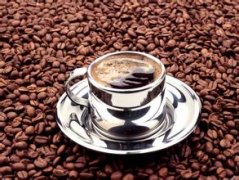Moderate and mellow Hassanda Coffee Manor in Ecuador the cultivation of boutique coffee beans is located in geography.

Between Colombia and Peru, Ecuador, which passes through the equator, is one of the few countries in South America that produces both Arabica and robastian coffee.
In fact, Ecuador means "equator" in Spanish. Due to the use of old-fashioned traditional harvesting and handling methods, Ecuadorian coffee is not listed as a boutique coffee, so it is generally rarely seen.
Ecuador faces the Pacific Ocean, and near the equator, about 900km off its west coast, near the equator at 90 degrees west longitude, there is also a dependency of the Galapagos Islands (Galapagos Island), also known as Cologne, which produces the famous Galapagos coffee. In order to protect the natural ecology, the Ecuadorian government has designated the archipelago as a national park and banned the use of chemical fertilizers, pesticides and other chemicals, so coffee in the Galapagos Islands is recognized as organic coffee.
Galapagos Islands coffee flavor is more balanced and neutral, moderately mellow, with a little obvious but pleasant acidity, with a special aroma. However, because it is seldom seen on the market, not many people talk about this coffee.
Between Colombia and Peru, Ecuador, which passes through the equator, is one of the few countries in South America that produces both Arabica and robastian coffee.
In fact, Ecuador means "equator" in Spanish. Due to the use of old-fashioned traditional harvesting and handling methods, Ecuadorian coffee is not listed as a boutique coffee, so it is generally rarely seen.
Ecuador faces the Pacific Ocean, and near the equator, about 900km off its west coast, near the equator at 90 degrees west longitude, there is also a dependency of the Galapagos Islands (Galapagos Island), also known as Cologne, which produces the famous Galapagos coffee. In order to protect the natural ecology, the Ecuadorian government has designated the archipelago as a national park and banned the use of chemical fertilizers, pesticides and other chemicals, so coffee in the Galapagos Islands is recognized as organic coffee.
Galapagos Islands coffee flavor is more balanced and neutral, moderately mellow, with a little obvious but pleasant acidity, with a special aroma. However, because it is seldom seen on the market, not many people talk about this coffee.
When Thomas and the crew landed on the island, they were frantically looking for water and were so thirsty that they squeezed juice from the fat leaves of the cactus to drink. At last a source of water was found in a rocky gully. Thomas attributed it to the gift of God, because it was good Friday, and they had piously celebrated mass before they set out in search of water. But Thomas will never know that the island they landed on is the only island in the Galapagos archipelago that has plenty of fresh water, today's St. Cristobal Island (SaintCristobal).
St. Cristobal is a larger island in the Galapagos archipelago. At 410m above sea level, there is a small lake called El.Junco, which forms streams along the rocks and volcanic rocks on the southern slope of the island. Mineral-rich fresh water moistens the land of St. Cristobal, keeping the soil moist and fertile. It provides the most rare conditions for the growth of coffee here.
In 1875, 340 years after Frey Thomas de Belanga discovered the island, a native named Corvus came to St. Cristobal, where he established the Hasunda Coffee Garden and planted about 100 hectares of Arabian bourbon coffee trees. Because the plantation is located between 140m ~ 275m above sea level and the climate is equivalent to that of inland 915m ~ 1830 m, the unique geographical conditions are very suitable for the growth of super hard coffee beans (SHB) with high acidity, so this high-quality coffee has settled down here.
As coffee is consumed by people all over the world, the world coffee industry is also moving towards mass production, while St. Cristobal, a small and unreliable coffee industry, is in trouble and is likely to be forced to give up without profit. It wasn't until the early 1990s that the Gonzalez family bought Hasunda Coffee Park. The localized microclimate caused by the Humboldt current (HumboldtCurrent), strong equatorial sunlight and sharp temperature changes (43 ℃ at sea level and 10 ℃ to 16 ℃ above sea level) provided advantageous conditions that prompted the Gonzalez family to expand their coffee plantation. By reclaiming the early land, the Gonzalez family doubled the size of the coffee plantation.
Ecuador is the highest Arabian coffee plantation in the world. Since the coffee tree was first introduced into Ecuador in 1875, the quality of its coffee has remained unchanged for 100 years, especially the coffee harvested in early June every year, which is called "the best coffee in the world". Ecuadorian coffee beans are divided into Galapagos and Segante, both of which have large particles and heavy weight. In particular, the unique geographical conditions of the Galapagos Islands give coffee beans excellent genes that are superior to those of other producing areas, and its high quality comes from the absence of any chemical agents when growing. As Ecuador's land suitable for Arabica coffee trees is dwindling, Galapagos coffee is even more valuable as the world dessert champion in 1995 and the European dessert champion in 2000, Mr. Marcolini's philosophy of success is absolute respect and dedication to ingredients. Ten years ago, he decided to be a great chocolate maker, looking for the best quality cocoa beans from all over the world to find the roots of chocolate-to unleash the true taste of chocolate. All the products sold in the Marcolini store, whether they are chocolate, almond cakes, jam, caramel, are made in the Marcolini workshop and are pure in taste and come from the original cocoa beans. The Marcolini brand has 14 cocoa beans from different regions, led by Ecuador, followed by Brazil, Cuba and so on.
Important Notice :
前街咖啡 FrontStreet Coffee has moved to new addredd:
FrontStreet Coffee Address: 315,Donghua East Road,GuangZhou
Tel:020 38364473
- Prev

Fragrant Hassanda Coffee Manor in Ecuador, the planting market price of boutique coffee beans is simple.
Flavor: balanced acidity, aromatic fragrance recommended roasting methods: medium to deep roasting, can be made into high-quality mixed coffee, suitable for multi-purpose evaluation: generally the best Ecuadorian coffee is grown on the island of San Cristobal in the Galapagos Islands, here has the unique natural geographical conditions for giving birth to the best quality coffee in the world. A cup of Galapagos coffee, Jude
- Next

Flavor and flavor characteristics of boutique coffee beans in San Pedro Manor, Puerto Rico
In fact, any kind of coffee will be given a unique flavor because of its origin, just like different music styles will always give you different feelings. Puerto Rico Yaoke coffee has the characteristics of boutique coffee, its acidity is very stable, full of particles, complete flavor, rich aroma. The reason why Yaocote chose coffee beans better than other producing areas on the island is that they are grown at high elevations.
Related
- Does Rose Summer choose Blue, Green or Red? Detailed explanation of Rose Summer Coffee plots and Classification in Panamanian Jade Manor
- What is the difference between the origin, producing area, processing plant, cooperative and manor of coffee beans?
- How fine does the espresso powder fit? how to grind the espresso?
- Sca coffee roasting degree color card coffee roasting degree 8 roasting color values what do you mean?
- The practice of lattes: how to make lattes at home
- Introduction to Indonesian Fine Coffee beans-- Java Coffee producing area of Indonesian Arabica Coffee
- How much will the flavor of light and medium roasted rose summer be expressed? What baking level is rose summer suitable for?
- Introduction to the characteristics of washing, sun-drying or wet-planing coffee commonly used in Mantenin, Indonesia
- Price characteristics of Arabica Coffee Bean Starbucks introduction to Manning Coffee Bean Taste producing area Variety Manor
- What is the authentic Yega flavor? What are the flavor characteristics of the really excellent Yejasuffi coffee beans?

